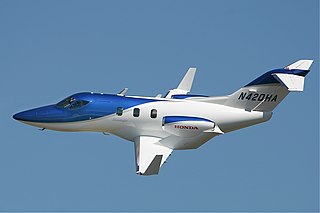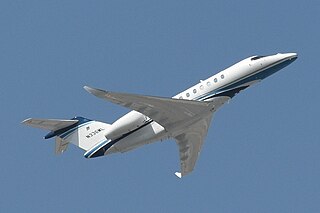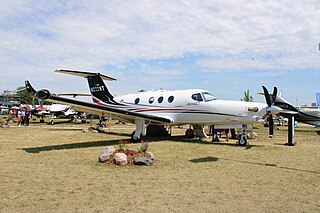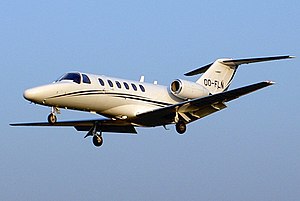
A business jet, private jet, or bizjet is a jet aircraft designed for transporting small groups of people, typically business executives and high-ranking associates. Business jets are generally designed for faster air travel and more personal comfort than commercial aircraft, and may be adapted for other roles, such as casualty evacuation or express parcel deliveries, and some are used by public bodies, government officials, VIPs, or even the armed forces.

The Learjet 60 is a mid-size cabin, medium-range business jet aircraft manufactured by Bombardier Aerospace in Wichita, Kansas. Powered by two Pratt & Whitney Canada PW305A engines, it has a range of 2,405 nautical miles (4,454 km) with NBAA 100 nmi (190 km) reserves, ISA. In July 2012 Bombardier Aerospace announced a temporary "production pause" of the latest variant Learjet 60XR to begin in the fourth quarter of 2012.

The Embraer EMB-500 Phenom 100 is a very light (VLJ) business jet designed and produced by the Brazilian aircraft manufacturer Embraer. Announced in November 2005, it made its first flight on 26 July 2007 and was awarded a type certificate in December 2008; the first aircraft was delivered the same month. The Phenom 100 has been stretched into the larger Embraer Phenom 300. Powered by two rear-mounted Pratt & Whitney Canada PW600 turbofans, it can transport four to seven passengers, with a range of 1,178 nautical miles [nmi] with four occupants. As of April 2023, 401 had been delivered.

The Cessna Citation Mustang is a very light jet that was built by Cessna. Launched at the 2002 NBAA convention, the Model 510 first flew on April 23, 2005. It received its FAA type certification on September 8, 2006, and was first delivered on November 22. Production ended in 2017 after 479 aircraft were built. The 8,645 lb (3,921 kg) maximum take-off weight jet is powered by two Pratt & Whitney Canada PW615F 1,460 lbf (6.5 kN) turbofans, can reach 340 kn (630 km/h), and has a range of 1,167 nmi (2,161 km).

The Honda HA-420 HondaJet is a light business jet produced by the Honda Aircraft Company of Greensboro, North Carolina, United States. Original concepts of the aircraft started in 1997 and were completed in 1999. It took its maiden flight on December 3, 2003, received its FAA type certificate in December 2015, and was first delivered that same month. By the end of 2021, 200 jets had been delivered.

The Hawker 400 is a light business jet. Initially designed and built by Mitsubishi, it has been further developed and updated by the Beech Aircraft Company, now part of Textron Aviation.

The Cessna Citation is a family of business jets by Cessna that started in 1972 with the entry into service of the first model. In the fifty years following the 1969 first flight, more than 7,500 Citations were delivered, forming the largest business jet fleet. Deliveries reached 8,000 by 2022, while logging over 41 million flight hours.

The Cessna Citation II models are light corporate jets built by Cessna as part of the Citation family. Stretched from the Citation I, the Model 550 was announced in September 1976, first flew on January 31, 1977, and was certified in March 1978. The II/SP is a single pilot version, the improved S/II first flew on February 14, 1984 and the Citation Bravo, a stretched S/II with new avionics and more powerful P&WC PW530A turbofans, first flew on April 25, 1995. The United States Navy adopted a version of the S/II as the T-47A. Production ceased in 2006 after 1,184 of all variants were delivered.

The Beechcraft Premier I is a light business jet aircraft manufactured by the Beechcraft division of Hawker Beechcraft. The aircraft was designed to compete with the Cessna CitationJet series of aircraft.

The Cessna Citation Excel is an American midsize business jet in the Cessna Citation family. Announced in October 1994, the Model 560XL first flew on February 29, 1996, certification was granted in April 1998, and over 1,000 have been delivered. The 2,100 nmi-range (3,900 km), 20,200 lb MTOW jet is powered by two 3,650–4,080 lbf (16.2–18.1 kN) PW545 turbofans, has the cruciform tail and unswept supercritical wing of the Citation V (560), and a slightly shortened Citation X stand-up cabin. The XLS 2004 update had upgraded engines and a glass cockpit and the 2008 XLS+ had upgraded engines and a revised nose.

The Cessna Citation III is an American business jet produced by Cessna and part of the Citation family. Announced at the October 1976 NBAA convention, the Model 650 made its maiden flight on May 30, 1979, received its type certification on April 30, 1982 and was delivered between 1983 and 1992. The cheaper Citation VI was produced from 1991 to 1995 and the more powerful Citation VII was offered between 1992 and 2000; 360 of all variants were delivered, while a proposed transcontinental variant, the Citation IV, was canceled before reaching the prototype stage. An all new design, the Citation III had a 312 sq ft swept wing for a 22,000 lb MTOW and a 2,350 nmi (4,350 km) range, a T-tail and two 3,650–4,080 lbf (16.2–18.1 kN) TFE731 turbofans. Its fuselage cross section and cockpit were kept in the later Citation X, Citation Excel and Citation Sovereign.

The Cessna Citation Columbus was a business jet project by Cessna, part of the Cessna Citation family. The Model 850 was launched in February 2008 and cancelled in July 2009. It would have been the largest model of the family at the time. Powered by 8,830 lbf (39.3 kN) PW810 turbofans and a 4,000 nmi (7,400 km) range, the $27 million aircraft had a 709 sq ft, 30° swept wing.

The Cessna Citation V is a business jet built by Cessna that was in production from 1989 until 2011. During that time, 774 such craft were made. The first Model 560 prototype, a stretched version of the Citation S/II, flew in August 1987 and was certified on December 9, 1988.

The Cessna Citation Sovereign is an American business jet developed by Cessna, part of the Cessna Citation family. Announced at the 1998 NBAA convention, the Model 680 made its maiden flight in February 2002, certification was awarded on June 2, 2004, and deliveries began in late September. The Citation Excel fuselage was stretched and joined with an all-new, larger wing and more powerful Pratt & Whitney Canada PW306C engines for increased maximum takeoff weight and a 3,200 nmi (5,900 km) range. The improved Sovereign+ was announced at the October 2012 NBAA for a first flight in April 2013 and deliveries in December, with added winglets and an improved flight deck and engines.
Nextant Aerospace is a United States-based company specializing in the remanufacturing of business jets. Founded in 2007, Nextant is the first company to introduce the concept of aircraft remanufacturing to the business jet market.

The Cessna Citation Longitude is a business jet produced by Cessna, part of the Cessna Citation family. It remains the largest business jet by Cessna. Announced at the May 2012 EBACE, the Model 700 made its first flight on October 8, 2016, with certification obtained in September 2019. The aluminum airframe has the fuselage cross-section of the Citation Latitude, stretched by a seat row. Powered by Honeywell HTF7000 turbofans, it has a new ~28° swept wing and a T-tail for a 3,500 nmi (6,500 km) range.

The Cessna Citation Latitude is a business jet built by Cessna. The Model 680A was announced at the 2011 NBAA convention, the prototype first flew on 18 February 2014, it achieved FAA certification on June 5, 2015, and first deliveries began on August 27. It retains the Model 680 Sovereign wing, twin P&WC PW306D turbofans and cruciform tail and adds a new stand-up circular fuselage with a flat floor, which was kept in the stretched, re-winged, and re-engined Cessna Citation Longitude.

The Pilatus PC-24 is a light business jet produced by Pilatus Aircraft of Switzerland. Following the success of the PC-12 single engine turboprop, work on the twin engine jet began in 2007 for greater range and speed, keeping the rugged airfield capability. The aircraft was introduced on 21 May 2013 and rolled out on 1 August 2014, with the maiden flight on 11 May 2015. The PC-24 received EASA and FAA type certification on 7 December 2017 and the first customer delivery was on 7 February 2018. Powered by two Williams FJ44 turbofans, it competes with the Embraer Phenom 300 and the Cessna Citation CJ4.

The Beechcraft Denali, also known as the Model 220 and previously the Cessna Denali and Textron "Single Engine Turboprop" (SETP), is an American single engine turboprop aircraft under development by Textron Aviation. Announced at EAA AirVenture Oshkosh 2015, the aircraft is a completely new design, not derived from any existing aircraft. It should compete with the Pilatus PC-12 and Daher-Socata TBM, as well as other new projects such as the One Aviation Kestrel K-350 and the CAIGA Primus 150.
The Cessna Citation Hemisphere was a business jet project by Cessna. Announced in November 2015, it was then expected to fly in 2019 but its development was suspended in April 2018 due to a delay in the development of its Safran Silvercrest engines. It was designed for Mach 0.9 and would have a 4,500 nautical miles (8,300 km) range.


























